
Maintaining a strawberry bed
Care of your first year plants
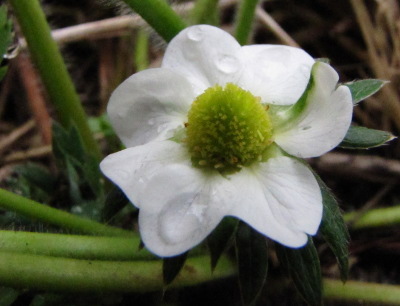 Your new plants will try to
bloom their first spring. For
best
results, carefully pick every flower off the plants so they'll put
their energy into growing healthy roots and leaves instead. Yes,
that means you won't get to taste your first berry until next year
--- it will be worth the wait. Using my growing system, this
first year is the only time you'll have to pick off flower buds since
you'll plant new strawberries in the fall from here on out. (Fall
planted berries have generally established themselves enough that you
can let them fruit their first spring.)
Your new plants will try to
bloom their first spring. For
best
results, carefully pick every flower off the plants so they'll put
their energy into growing healthy roots and leaves instead. Yes,
that means you won't get to taste your first berry until next year
--- it will be worth the wait. Using my growing system, this
first year is the only time you'll have to pick off flower buds since
you'll plant new strawberries in the fall from here on out. (Fall
planted berries have generally established themselves enough that you
can let them fruit their first spring.)
After trying to bloom,
the strawberry plants will send out lots of
runners. Those of you following the hill system will want to snip
back runners during your usual weeding sessions. You don't need
any fancy equipment as long as you catch the runners when they're young
and tender --- just pinch them off between your thumb and forefinger.
Strawberry plants often
keep green leaves through most or all of the
winter, but you'll want to put some mulch over top of the plants once
the rest of your garden has died back. Freezing and thawing can
otherwise push your berries' shallow roots up out of the ground and
kill the plants. Be sure to rake the mulch back from the tender
new
leaves in early spring and topdress the bed with a healthy coating of
compost, topped off with the old mulch plus a new layer of straw.
Flowering and fruiting
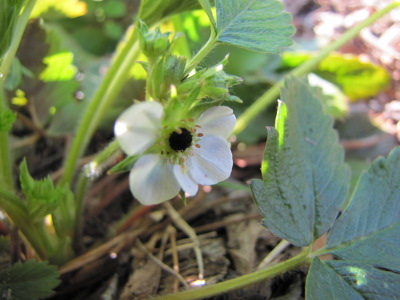 After patiently waiting 12
months, you're ready for your strawberry
harvest. This time, leave all of the blooms and keep an eye on
the weather. Late spring freezes can damage strawberry flowers,
so I toss row cover fabric over top of the plants if lows are expected
to drop below 30 degrees once flower buds have opened. You'll
know your flowers were damaged if the centers change from yellow to
black. All is not lost, though --- strawberry flowers tend to
open
a few at a time over the course of a week or two, so losing the
earliest flowers will just allow the plant to put more energy into
later fruits.
After patiently waiting 12
months, you're ready for your strawberry
harvest. This time, leave all of the blooms and keep an eye on
the weather. Late spring freezes can damage strawberry flowers,
so I toss row cover fabric over top of the plants if lows are expected
to drop below 30 degrees once flower buds have opened. You'll
know your flowers were damaged if the centers change from yellow to
black. All is not lost, though --- strawberry flowers tend to
open
a few at a time over the course of a week or two, so losing the
earliest flowers will just allow the plant to put more energy into
later fruits.
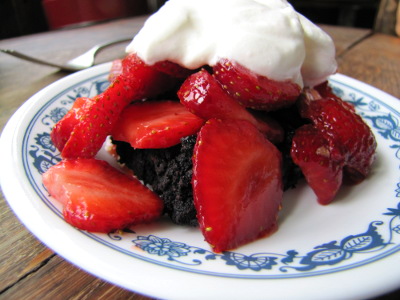 While watering is important
throughout the growing season, the time
between fruiting and harvest is a critical period. Strawberries
need an inch of water per week, and if the weather isn't cooperating,
you have to irrigate. Otherwise, just watch and wait, picking
your strawberries when they are bright red on the outside and at least
slightly red clear through. You'll need to set aside time to
harvest strawberries at least every other day, but daily harvesting is
better. Berries are sweetest in the afternoon and are least tasty
if picked right after a rain (or watering session.)
While watering is important
throughout the growing season, the time
between fruiting and harvest is a critical period. Strawberries
need an inch of water per week, and if the weather isn't cooperating,
you have to irrigate. Otherwise, just watch and wait, picking
your strawberries when they are bright red on the outside and at least
slightly red clear through. You'll need to set aside time to
harvest strawberries at least every other day, but daily harvesting is
better. Berries are sweetest in the afternoon and are least tasty
if picked right after a rain (or watering session.)
If you ever get sick of
grazing on fresh strawberries, Weekend
Homesteader: August tells how to make peach leather, a recipe that
can
be easily tweaked to produce the most delicious strawberry leather
you've
ever tasted. Or check out recipes for strawberry
freezer jam and chocolate
strawberry shortcake.
Renovating and expanding the strawberries
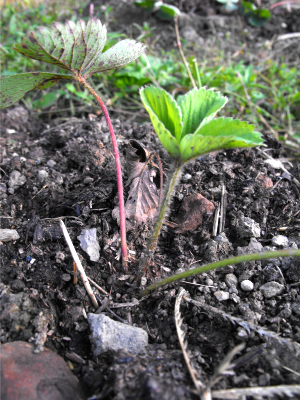 After gorging on
strawberries in May or June, it's time to start
plucking runners again. This year, you don't need to be quite as
careful about removing every single runner because you'll want to
expand your patch. By the middle of summer, missed runners will
have rooted and turned into new strawberry plants. When the
weather forecast promises three or more rainy days in a row, head out
into the garden with your trowel and carefully dig up all of these baby
strawberry plants, then start a second patch in a new garden bed.
This is another time when irrigation is critical since summer-planted
strawberries can easily wither up and die before they get their feet
under them.
After gorging on
strawberries in May or June, it's time to start
plucking runners again. This year, you don't need to be quite as
careful about removing every single runner because you'll want to
expand your patch. By the middle of summer, missed runners will
have rooted and turned into new strawberry plants. When the
weather forecast promises three or more rainy days in a row, head out
into the garden with your trowel and carefully dig up all of these baby
strawberry plants, then start a second patch in a new garden bed.
This is another time when irrigation is critical since summer-planted
strawberries can easily wither up and die before they get their feet
under them.
If you use my method of
expanding the patch in the late summer, you can
skip this step, but otherwise you'll need to renovate your bed in the
fall. Many sources recommend mowing off the strawberry leaves,
but I find that step unnecessary. Instead, I simply rip out
plants that have gotten too close together, leaving at least one foot
of mulched soil between each plant.
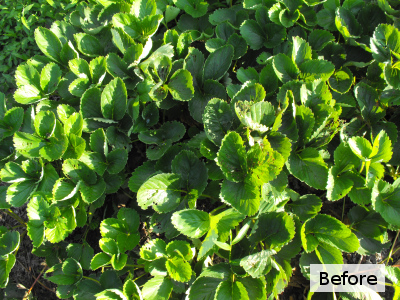
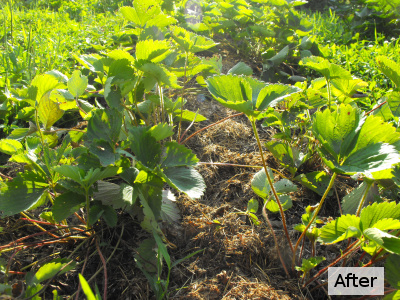
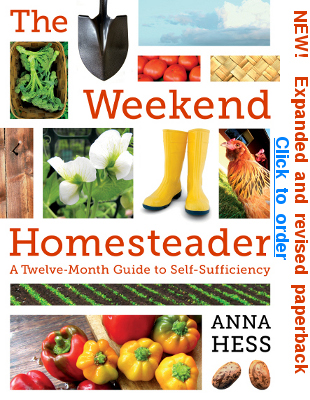 I've found that flavor
and vigor begin to diminish after a strawberry
patch has fruited once, twice, or three times. (How many seasons
you can eke out of the plants depends on the quality of your
soil.) I
generally eat two years' worth of strawberries from a bed, then rip the
plants out and rotate the bed back into the general vegetable
garden. As long as I transplanted runners the previous year, I'll
have a fresh bed ready to produce more berries the following
spring.
I've found that flavor
and vigor begin to diminish after a strawberry
patch has fruited once, twice, or three times. (How many seasons
you can eke out of the plants depends on the quality of your
soil.) I
generally eat two years' worth of strawberries from a bed, then rip the
plants out and rotate the bed back into the general vegetable
garden. As long as I transplanted runners the previous year, I'll
have a fresh bed ready to produce more berries the following
spring.
This
week's lunchtime series is exerpted from Weekend
Homesteader: February,
which is available for 99 cents from Amazon's kindle store. The
ebook
also includes a primer on choosing and caring for a backyard flock of
chickens, information on buying in bulk, and tips for creating your own
apprenticeship. If you enjoy the book, please consider leaving me
a
review.
| This post is part of our Easy Berries lunchtime series.
Read all of the entries: |
Want more in-depth information? Browse through our books.
Or explore more posts by date or by subject.
About us: Anna Hess and Mark Hamilton spent over a decade living self-sufficiently in the mountains of Virginia before moving north to start over from scratch in the foothills of Ohio. They've experimented with permaculture, no-till gardening, trailersteading, home-based microbusinesses and much more, writing about their adventures in both blogs and books.
Want to be notified when new comments are posted on this page? Click on the RSS button after you add a comment to subscribe to the comment feed, or simply check the box beside "email replies to me" while writing your comment.

I think of letting strawberries fruit the first year as similar to letting an animal give birth when it's not fully grown. (Think of a 13 year old girl having a baby --- it's going to be very tough on her and will probably stunt her growth.)
June bearing strawberries actually do most of their reproduction from runners, not seeds. They're likely to set some runners no matter how hard you try to keep them all picked off. So you don't want the first year plant to stress itself out by reproducing both ways.